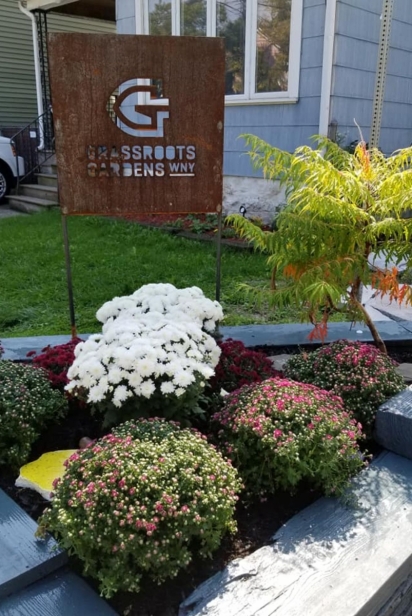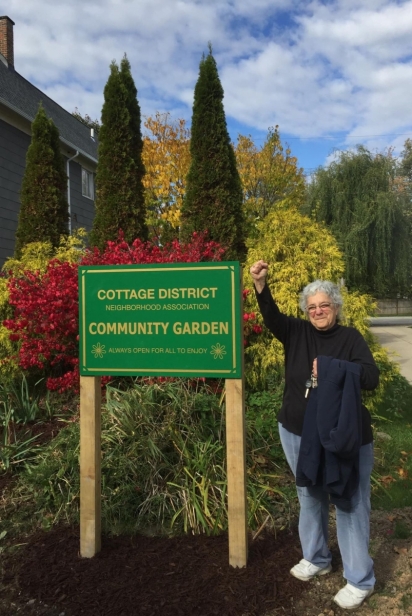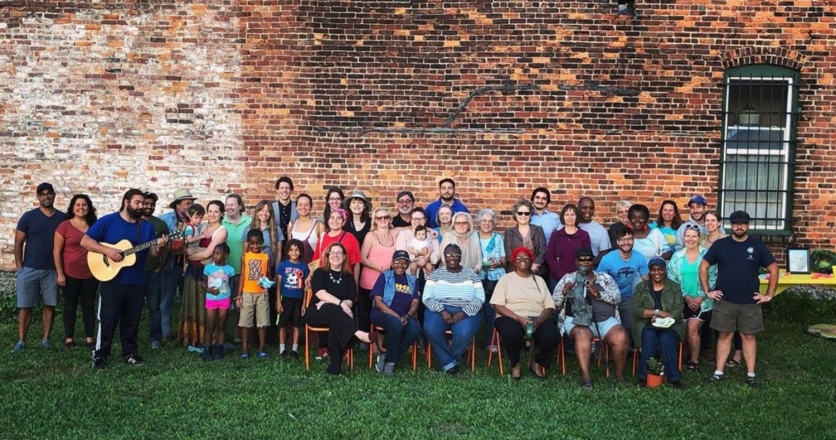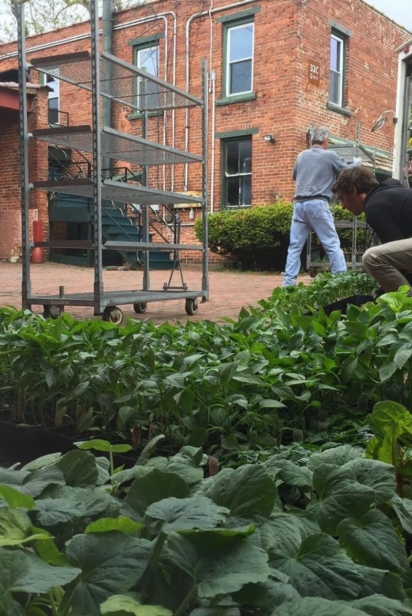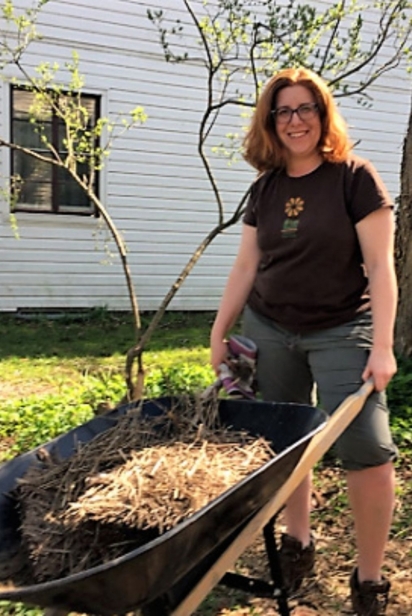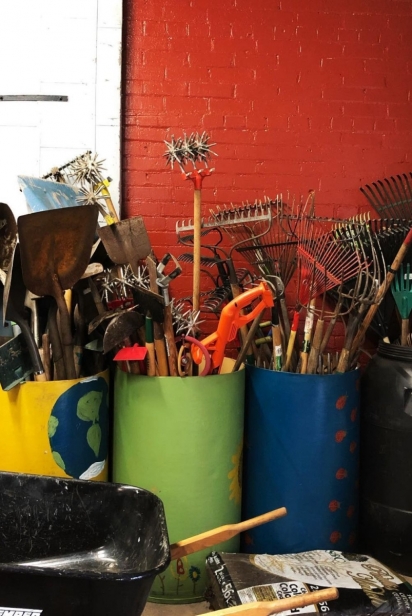THE GREENING OF BUFFALO
“Rain barrels,” writes Jeanette Koncikowski, on a whiteboard, adding to a list that includes “composting, pollinator plants, signage and accessible.” It’s a Wednesday night and Koncikowski, executive director of Grassroots Gardens of Western New York (GGWNY), is in the organization’s new headquarters on Buffalo’s east side, collecting ideas for their on-site garden. Gathered in the room are a dozen or so gardeners, participants in GGWNY’s monthly Gardeners Committee meeting. They’re just a handful of the estimated 2,000 gardeners in the GGWNY network, which includes more than 110 gardens in the cities of Buffalo and Niagara Falls.
Walk around most neighborhoods in Buffalo and you won’t go many blocks before stumbling upon a Grassroots garden. If you’re in Black Rock, you might see kids at the Mayer Avenue Community Garden, reading on a hand-carved wooden bench with Michelle Kowstaniak. In the Broadway-Fillmore neighborhood, you might come upon Lloyd Crawford and guys he’s been playing football with for decades, harvesting a bounty of watermelon, tomatoes and cabbage. You might see Gerldine Wilson tending poppies at the Victoria Avenue Community Garden, which she started in 2012 to provide sorely needed food and solace for her neighborhood. On a summer evening on the west side, you might find Ellie Dorritie and other Cottage District Block Club members enjoying a movie night, lawn chairs casting long shadows over flower and vegetable beds.
“Every neighborhood should have one of these. Why not turn vacant land into something the whole neighborhood can benefit from?” says Crawford, standing next to the four 4x8-foot raised beds he installed for his garden’s inaugural year. We’re on a double lot that not too long ago was a dumping site, in a neighborhood where Buffalo’s industrial past and the needs of the present collide. “I’m more of a connector than a gardener,” Crawford laughs. “But we get by.”
CELEBRATING 25 YEARS
About 30 of GGWNY’s gardens are at schools but most are in neighborhoods, where they are sources of fresh produce for the many people living in food deserts. Many are also surprising, welcome spaces of respite and beauty. All are places that build connection or, as GGWNY says, grow communities.
Started in 1995 by J. Milton Zeckhauser and other community activists, Grassroots Gardens celebrates its 25th anniversary this year. The organization continues to support individuals, communities and society, with the mission of sharing “knowledge, power, and resources to help heal systemic harm and strengthen neighborhood connections through community gardening.”
On Earth Day, Wednesday, April 22, GGWNY planned to officially break ground for a garden next to its new headquarters at 389 Broadway, and announce their big plans for their anniversary year, celebrating the many people who’ve been impacted by GGWNY over the last 25 years, and looking forward to the potential of the next 25. It now hopes to move the 25th Anniversary Celebration to the summer. In the meantime, the current pandemic underscores the important role that community gardens play in ensuring food security for everyone in the city.
Branded as their new Community Garden Resource Center, the headquarters includes office space for GGWNY’s mighty crew of four paid staff, meeting room for community meetings and workshops, a kitchen, and a garage repurposed as a gardeners’ tool library, where gardeners can access everything from seedlings to rakes. Most importantly, the new headquarters includes an expansive outdoor space for a teaching garden, which will feature several small demonstration gardens, a donated greenhouse, and open beds for collective planting by neighbors.
“The GGWNY teaching garden will be a co-creation, as all of our gardens are: different members of the community coming together to create something beautiful and new and needed,” says Koncikowski, who came to GGWNY in May 2018. During her first summer on the job, she spent a couple days a week touring the gardens, where she heard the stories that make up Grassroots Gardens.
A JOURNEY PAVED WITH STORIES
“I started my garden with the hopes of feeding people’s stomachs, but it turned out to be a whole lot more than that,” Wilson says. “Nothing did for me what my garden did.”
“Everybody has a story, everybody has a journey, and everybody has a place in their lives that they’re down, that they’re not on the mountaintops,” says Ranisha Litten, a new board member and gardener at Niagara Falls’ LaSalle Vineyard garden. “So, when they’re down, having something like Grassroots as a resource can be life-saving.”
Gardeners’ stories motivate Koncikowski and the staff at Grassroots, driving efforts such as the Therapeutic Gardening Initiative, which launched in the spring of 2019. This year, GGWNY will pilot three therapeutic community gardens in residential facilities, building on the healing elements of the natural world. “We want these three gardens to provide respite for women and children who are going through difficult transitions in their lives,” says Koncikowski.
Another community-led initiative, their Accessibility Task Force, has spent a year evaluating a sample of gardens for ease of access for people with vision, hearing or mobility needs. GGWNY is hoping to secure funding to add elements of universal design to at least 10 gardens this year, making changes like adding grass mats for wheelchair users, addressing communication access for deaf gardeners, and putting out more wayfinding signs, in braille or with QR codes.
FACILITATOR, EDUCATOR, ADVOCATE
“As a community-led organization, the role of Grassroots Gardens is to listen to and enact the vision of its gardeners—to facilitate, to advocate, to push for change,” explains Koncikowski.
They offer financial support by funding each new garden for its first two years, providing resources like natural lumber for raised beds, seeds, cleam soil from a trusted vendor—and soil testing, all critical for safe growing on the often abused, formerly industrial land of the city. Through their free educational programming, GWNY provides workshops throughout the year, partnering with community members and organizations to teach and build capacity on everything from safe soil practices to cultural competency.
GGWNY also negotiates and holds master leases with the cities of Buffalo and Niagara Falls, ensuring that the publicly owned vacant lots that most of the gardens sit on will not be rezoned or sold off for commercial development. The organization ended the 2019 gardening season with the huge success of a five-year master lease with the city of Buffalo; since 2013, while the proposed lease had been under legal review, the gardens were left vulnerable to sale, protected only on a month-to-month basis.
One of GGWNY’s big undertakings of 2020 is to seek national accreditation as a land trust. A community land trust is land owned by the community—and in this case to remain protected as a garden in perpetuity. GGWNY already holds title for two of its member-gardens, the Cottage District Garden and Tyler Street Garden. “The status will push us to grow formally by setting big-picture goals, and give the organization and its members a stronger sense of value and belonging to something much greater,” says Ellen Barnum, board president, who started as a volunteer in her kids’ school garden in 2012.
The formal accreditation as a land trust operating at “highest standards”—and the accompanying clout—will hopefully support GGWNY’s aim of getting more gardens into its community land trust. With myriad research showing the low cost and high impact of gardens on crime reduction, social infrastructure and public health, and over 7,000 vacant lots in Buffalo, GGWNY believes that the city has an opportunity to recognize the contribution of gardeners, to preserve greenspace—and to be an agent of change.
“You notice a big difference in neighborhoods with community gardens and those without. In those with community gardens, the neighbors know each other, they help each other out,” says Barnum.
SEEDS OF STRONGER COMMUNITIES
“I like to think that the renaissance in Buffalo started around the same time our explosion of gardens did,” says Koncikowski, who states that GGWNY has a goal of bringing one garden from each council district into the land trust, in addition to at least one in Niagara Falls. “But it’s part of my job to make sure no one gets left behind from our regional and organizationa progress—that we do this in a way that is fair and equitable to the community.”
For Ellie Dorritie, a longtime gardener and community activist in the Cottage District, the garden is a visible display of the community’s collective power. “The lot itself, our water spigot, that it’s like a park in the summer—all of it shows that City Hall can work for us. It changes the whole way we function together. It’s the reason we garden together.”
“Gardening, particularly if you’re in a community without easy access to fresh, healthy food, is a radical act,” says Koncikowski. “That someone can walk down the block, plant seeds and literally six weeks later harvest food for their family: that is revolutionary.”



